#red leafy recipes
Explore tagged Tumblr posts
Video
youtube
আজ আমার কুড়ে ঘরে ক্ষেতের টাটকা লাল শাক তুলে শুটকি ভর্তা সাথে ডাল আলু ভাজ...
#recipes#cooking#dry fish recipes#red leafy recipes#red spinach recipes#dal ranna#vorta recipes#how to cook#village life#farm fresh
0 notes
Text
Chef Bob's Zesty Lemony Chicken Salad Recipe
Chef Bob's Zesty Lemony Chicken Salad Recipe - #lemonchickensalad #chickensalad #chickenwings #garchabros #takeaway #salad #canada #chickentikka #cookedfood #malaichicken #meatshops #healthysalad #diabeticsalad #grilledchicken #diabetes #leafygreens #yum
Welcome to a delightful culinary experience with Chef Bob’s Lemony Chicken Salad! This refreshing dish combines the zesty flavors of lemon with tender chicken, crisp vegetables, and a tangy dressing. Perfect for a light lunch or a picnic treat, this salad is not only delicious but also packed with nutritious ingredients. Let’s dive into the details! Ingredients For the Salad: 2 cups cooked…
#canada#celery#chicken baked lunch#chicken recipes#chicken salad#chicken tikka#cooked food#Diabetes#diabetic salad#dinner#family#food#food blogger#foodie#foodporn#foodstagram#grilled chicken#healthy salad#home made salad#homemade#leafy greens#Lemon#lemon chicken salad#malai chicken#meat shops#red bell peppers#red onions#salad#salad dressing
0 notes
Note
If I may please ask a question on your soup stock recipe: could you use /any/ vegetable bits or am I better sticking to ones that you listed? Specifically the other veggie types I'd most likely end up with scraps of are stems of leafy greens, (sweet) potatoes, and bell peppers. I could especially see potential issues with the first two of those, so I thought I would check what your experience/cooking knowledge thought.
the sweet potatoes and bell peppers are going to have a pretty strong influence on the flavor of your stock, but hey you may as well try it and see if it tastes good to you.
I made some stock a while back that ended up being very funny because I had a bunch of red cabbage scraps in the freezer bag so the stock came out noticeably blue/purple, but it tasted really good.
I don't put bell peppers in my stock because large bastard hates them; i just made a big pot of stock that had a LOT more mushrooms than my normal stock and has a noticeably mushroomy flavor, which will limit the things that would be suitable to cook with that batch. It all depends!
87 notes
·
View notes
Text
Red Cabbage (Harvestable)

Red Cabbages, or purple cabbages owing to their brilliant leaves of purple hues, emerge from the centre of leafy plants. The 'head' of cabbage is delicious pickled, eaten raw in salads, and always adds a bright pop of colour and crunch to most dishes.
*Requires the most recent main Harvestables file.
Category: Veggie
Season: Summer, Fall
Rarity: Common
Use it in custom recipes, (such as my Beef Brisket), or recipes that require veggies
Find it in the Summer and Fall seed packets
Find it on a grocery delivery order on days when Red Cabbages are stocked. As with all fruits and veggies, these days will rotate and fruit stocks will be random. (Cottage Living)
Has a custom Notebook Entry from researching
DOWNLOAD (Early Access): Red Cabbage Milk and Cookies: Now! Sugar Cookies: 23rd May Public: 30th May
#tianasims#ts4 gardening mods#ts4 custom harvestable#the sims 4 gardening#ts4 gardening#ts4 maxis match cc#ts4 mm cc#the sims 4 plants#ts4 functional mods#ts4 functional cc#the sims 4 green thumb#ts4 seasons#ts4cc#thesims4#customharvestables#the sims 4 custom plants#the sims 4
30 notes
·
View notes
Text
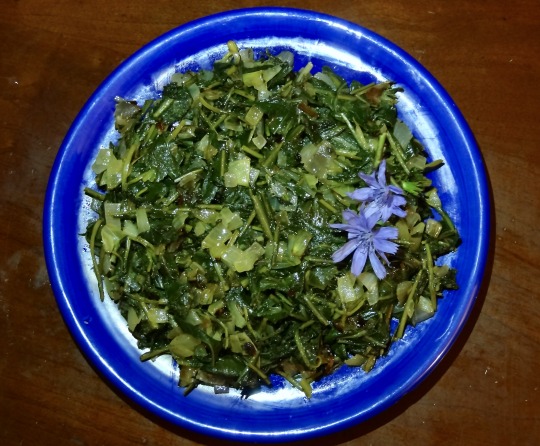
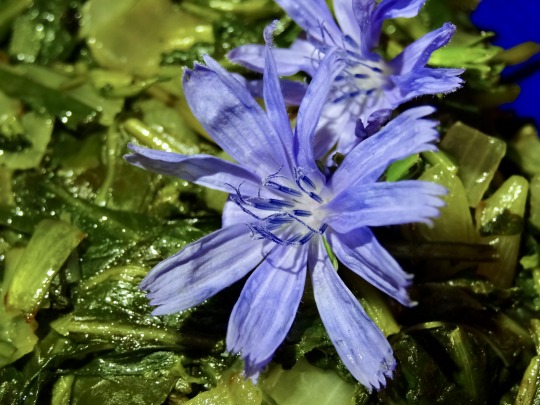
[ID: A plate of leafy greens topped with two blue chicory flowers; second photo is a close-up on a flower. End ID]
هندبة بالزيت / Hinda b al-zayt (Palestinian wild greens with olive oil)
“هندبة” (“hindba”), “هِنْدِبَاء” (“hindibāʔ”), or هِنْدَب (“hindab”) is an Arabic word referring to chicory, wild endive, or dandelion greens.
Two Palestinian dishes are commonly made using hindba. One isهندبة بزيت (hinda b zayt), hindba with [olive] oil, which combines blanched greens with browned onion, lemon juice, and (of course) olive oil. Lebanese hindba is similar, consisting of greens prepared in the same way, but topped with sliced, caramelised onions. The other preparation of hindba is with a dressing made with tahina (tahini), lemon juice, chili, and sometimes garlic or yoghurt.
This recipe is for hindba with onion and olive oil. The dish is simple to make but has a lot going on, flavor-wise. Slow frying renders the onions tender, sweet, and jammy, balancing out the slight bitterness of the greens. The rich, peppery, fruity taste of good olive oil rounds out the earthiness of chicory, while lemon juice provides brightness and lift.
Several food aid organizations have been forced to discontinue operations in Gaza. Some of those still on the ground are:
Palestinian Red Crescent Society
World Central Kitchen
Anera
Ingredients:
2 bunches (130g) chicory or dandelion leaves
1 large yellow onion, chopped
Juice of 1 lemon
Olive oil
Salt, to taste
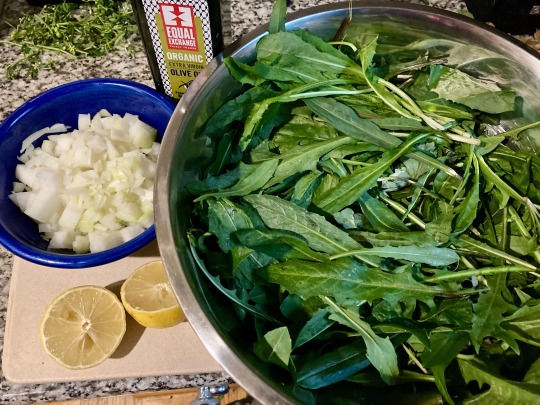
Instructions:
1. Boil chicory in salted water for 5-7 minutes, until tender, then drain. If using dandelion greens, boil for 10 minutes. (The boiling water is potable, but probably too bitter to be palatable.)
2. Heat olive oil in a large skillet on medium-low. Add onion and a pinch of salt and fry until softened and golden brown, 10-15 minutes.
3. Squeeze the water out of the greens and chop into about 1/2" (1cm) pieces. Add to the pan and fry until wilted.
4. Taste and adjust salt. Add lemon juice to taste.
Serve hot or cold, topped with good olive oil. Eat hindba by scooping it up with khubbiz al-kmaj (pita).
Identifying chicory:
Common chicory (Cichorium intybus) is also in the Astaraceae family. Stems are grooved and slightly hairy; woody and branched; multiple flowers usually grow along one stalk. Leaves are smooth or irregularly toothed, pointed at the tip, and may have different appearances at different parts of the plant. The leaf midribs are green or reddish. The leaves you want are the larger ones growing in a bunch towards the base of the stem.

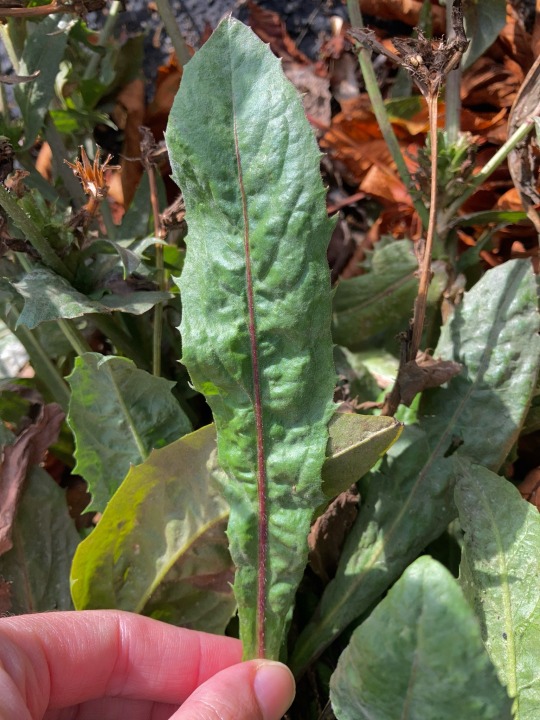
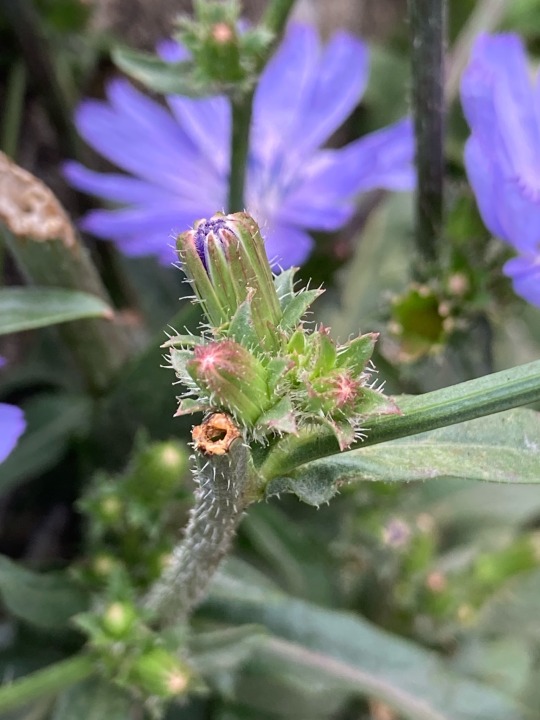
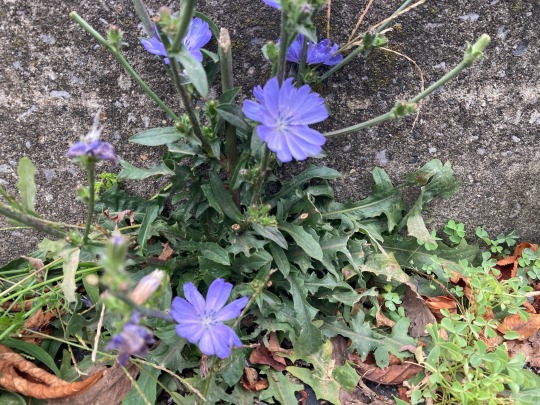
This plant has some leaves with larger teeth.
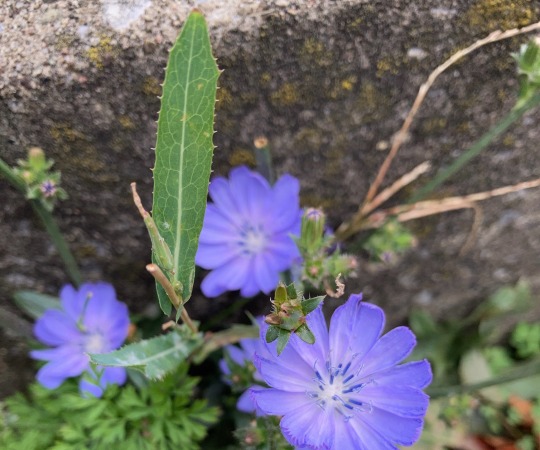
Smaller, lanceolate leaves grow in alternate sides along the stem.
Flowers are light blue to lavender and finely toothed; there are two rows of darker bracts in the center of each flower.
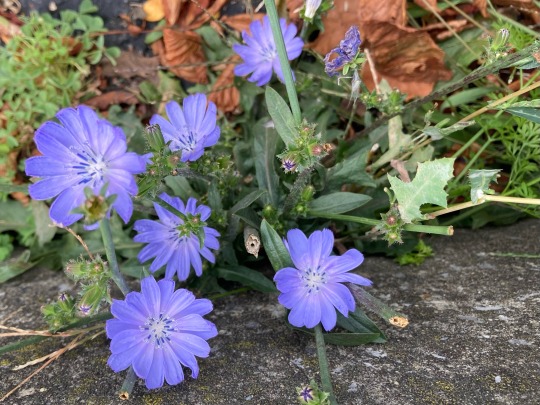

In the fall, the leaves often remain while the flowers and stalks have died, leaving a brown, branching, skeletal structure behind.


Identifying dandelion:
See hinda b al-tahina.
80 notes
·
View notes
Text

Thai-inspired Green Curry Chicken with Vegetables
Ingredients:
* 1 tablespoon coconut oil
* 1 pound boneless, skinless chicken thighs, cut into bite-sized pieces
* 1 green bell pepper, sliced
* 1 red bell pepper, sliced
* 1 cup broccoli florets
* 1 (13.5-ounce) can coconut milk
* 1-2 tablespoons green curry paste (depending on desired spice level)
* 1 tablespoon fish sauce
* 1 tablespoon soy sauce
* 1 cup chopped baby spinach
* Lime wedges (for serving)
* Cooked brown rice (for serving)
Instructions:
* Heat coconut oil in a large skillet or pot over medium heat. Add chicken and cook until browned on all sides.
* Add bell peppers and broccoli to the pan and cook for 5 minutes, or until slightly softened.
* Stir in coconut milk, green curry paste, fish sauce, and soy sauce. Bring to a simmer and cook for 10 minutes, or until chicken is cooked through.
* Stir in spinach and cook for 1 minute, or until wilted.
* Serve over cooked brown rice with lime wedges for squeezing over the top.
This recipe is rich in:
* Iron from the chicken and dark leafy greens (spinach) for healthy blood flow.
* Calcium from the coconut milk for bone health.
* Folic acid from the dark leafy greens which can be beneficial before conception.
Enjoy this flavorful and healthy Thai-inspired dish!
#food photography#food fight#comfort food#fast food#food for thought#healthy food#foodie#food#foodpics#foodmyheart#foodlover#tw food#pasta recipes#pasta recipe#salad recipes#soup recipe#recipe#reciprocidade#reciprocity#recipies#recipes#lunch recipes#cozy fall#cozy art#cozyhome#cozy cozy#healthy salad recipes#healthy lunch ideas#healthy lunch#healthy diet
24 notes
·
View notes
Text
While Rosh Hashanah is generally known for its sweet foods like apples and pomegranates, there’s an ancient, slightly less-sweet, Sephardic tradition of eating foods for what they represent rather than what they taste like. Dark and leafy beet greens, plucked from their sweet, earthy roots are one of those foods.
It all stems from the fact that beet greens were once the favored part of the crop. Gil Marks wrote in “The Encyclopedia of Jewish Food” that early Mediterranean farmers cultivated beet greens and not their roots, which were stringy and small — and not desired until much later. It wasn’t until the mid 1500s that the modern juicy red beet root was cultivated, in Germany or Italy.
On Rosh Hashanah, beet greens or chard (“silka” in Aramaic) became a symbol for the new year, along with squash, fenugreek, leeks and dates, each with their own symbolic meaning.
These foods are served and reflected upon with special blessings full of word play and puns during the the Sephardic Rosh Hashanah seder. Beet greens (“selek” in Hebrew and “silka” in Aramaic), for example, embody the hope that all enemies will be removed in the new year. Both “selek” and “silka” resemble ways of saying “removal” in Hebrew and Aramaic.
Over time, beet roots were favored over their leafy tops, but today, resourceful cooks are using the whole plant. If it’s there, why not put it to use? You’ll reduce your food waste and boost your meal with added vitamins and minerals while you’re at it.
You can find beets and their greens at farmers markets or in well-stocked produce sections. You’ll have to remove the greens from the beets yourself, and it’s best to do this as soon as you can — that way, the beets stay firm and the leaves stay fresh. I often remove the leaves and place them in a separate bag right after I purchase them at the farmers market, so that they don’t get damaged on the way home.
Cooking the greens is the easy part — just use them in place of spinach or Swiss chard. And don’t worry, you can cook the stems too — my favorite thing to do is add them to vegetable stock or saute them with the leaves.
Here are five recipes that might inspire you to bring the beet greens into your Rosh Hashanah tradition:
Iraqi False Mahshi: Layered Swiss Chard, Beets, Rice and Beef from The New York Times
Fried Beet Greens Meatlessballs from Food 52
Greek Beet and Beet Greens Pie from The New York Times
Sauteed Beet Greens with Garlic and Walnuts from Edible Berkshires
Salad of Beet Greens and Walnuts from the Los Angeles Times
8 notes
·
View notes
Note
i'm super bad at cooking and never know where to start because every recipe out there asks for ingredients i simply don't have at home so do you perhaps know what basic ones would be good to stock up on? like eggs and stuff...especially when it comes to spices i have no idea what is okay to use
Haii o/ very honored that you sent me an ask, and ofc I’ll do my best to help! This reply got a bit out of hand so. Long text under the cut. Behold. Feel free to reach out in asks or dms or whatever with any future questions (@ everyone tbh).
Food is, of course, very subjective, so my idea of a perfect list of foods to keep a stock of will not be universal, but I hope this will, at least, give you some ideas if anything.
First of all, I usually mentally break down my typical weekday recipe into vaguely carbs source - protein source - veggies, buy a couple of options for each category and just switch them around for variety. My standard set is
rice / pasta (usually spaghetti re:shapes) / glass noodles
eggs / chicken / tofu / bacon
random pack of frozen vegetables, bell peppers, eggplants, tomatoes, cucumbers, leafy greens. garlic and onions too
I have an option of making egg fried rice with chopped up bacon and added frozen vegetables one day, then blending the leftover vegetables with bell peppers and tomatoes to use as pasta sauce with chicken and spaghetti the next day, then branching out and making eggplant tofu stir fry with glass noodles, then using whatever eggplant tofu stir fry i had left as rice balls filling and making myself a quick vegetable salad on the side… And all those things are easy to make and don’t need much fussing around.
Other options to consider would be potatoes (you can roast them with whatever, boil, fry, etc), buckwheat (my wife doesn’t like it otherwise I’d use it more often), kidney beans and chickpeas for your carbs*; fish and meat for your proteins (those are. a bit too expensive for me usually); carrots, cabbage, leeks etc.
The list looks long, but, again, you just need to pick out a couple of things from each group and throw shit in a pan so to speak. And a lot of them are easily soup-able (boiling water chicken potatoes carrots rice? boom soup. etc), which is another easy base recipe to exploit.
Now to the matter of spices. Salt and pepper are obvious enough, but a good thing to look for are, especially if you are just getting into cooking, spice blends. Something something French Herbs™ something something Taco Seasoning™ something something Seven Spice™ something something Garam Masala™. There’s a lot of different ones, but they are, essentially, a formed flavor profile in themselves, so you don’t need to worry about mixing spices and herbs that might not go well together, and by paying attention to contents you can learn for yourself what individual seasonings are commonly used together.
Also, everyone, hold your judgement real quick and trust me with this, but ooh I always save leftover flavor packets from instant ramen and reuse them in other dishes. Egg fried rice just doesn’t taste right without suspicious red powder courtesy of shin ramen… It’s probably MSG my beloved or something…
While I’m at it, bouillon cubes are handy to have, you can use them for soups, crumble them up in other recipes. Adding one to the water you’re cooking rice in is a great hack at making it more flavourful.
In general, while I do actually have way too much spices (and keep buying more… very excited about my newly acquired dried tarragon…), the ones I’d advise to have for an average person would be:
Salt (ideally both coarse grain and fine grain, but fine grain only serves you just right)
black pepper (both in a mill/grinder and peppercorns), red pepper flakes
paprika, garlic powder, ginger powder
bay leaves, dried oregano, basil, thyme, dill, cinnamon, coriander, cardamon, cumin, turmeric, sumak....
I really got a bit carried away by the end, but. You don't actually need to buy all of them and at the same time, just start with whatever couple of things you'd need for whatever you are cooking and let your collection build up over time, since spices aren't something you need to buy often anyway 👍
Other things I think it’s nice to have in stock in your kitchen would be flour and baking powder, vinegar (distilled vinegar, rice vinegar… I like to have balsamic vinegar too but it’s so expensive it’s ridiculous ngl), soy sauce, cooking oil of your choice (I use sunflower oil, olive oil and sesame oil), panko or breadcrumbs, starch (i have potato starch, cornstarch and tapioka starch, I would suggest just getting cornstarch at first).
* going to clarify here that while beans are often brought up as a source of protein, most are rich in complex carbs, excluding edamame and green beans for example. And since I mostly often cook beans with meat, they check out my daily carbs in my head.
8 notes
·
View notes
Text
Pork Noodle Soup With Ginger and Toasted Garlic
YIELD 4 to 6 servings
TIME 35 minutes
“This soup, based mostly on pantry staples, can be made with a variety of proteins, noodles and greens depending on what you have on hand. Snow pea leaves are exceptional here, which can be found in many Asian grocers year-round, but spinach, Swiss chard or other dark leafy green would work well. Don’t skip the raw onion, the soup’s finished complexity depends on it. “ - Alison Roman
INGREDIENTS
3 tablespoons neutral oil, grapeseed, vegetable or canola
8 garlic cloves, thinly sliced
1 pound ground pork
1 ½ teaspoons red-pepper flakes, plus more to taste
Kosher salt and black pepper
4 cups chicken broth
4 cups water
3 tablespoons soy sauce or tamari, plus more to taste
1 large bunch pea leaves or spinach, thick stems removed, leaves coarsely chopped
1 tablespoon finely grated fresh ginger (from about a 1 1/2-inch piece)
6 ounces rice noodles (thick- or thin-cut), cooked and drained
½ medium red, yellow or white onion or 3 scallions, thinly sliced
1 cup fresh cilantro, leaves and tender stems, coarsely chopped
PREPARATION
Heat vegetable oil in a large, heavy-bottomed pot over medium.
Add garlic and cook, stirring occasionally, until the slices become nicely toasted and golden brown, 2 or 3 minutes. Using a slotted spoon, remove garlic and set aside.
Add pork and red-pepper flakes to the pot, and season with salt and pepper. Cook, using a wooden spoon or spatula to break up large pieces, until the pork is well browned and in small bite-size pieces, 5 to 8 minutes.
Add chicken broth, soy sauce and 4 cups water. Bring to a simmer and cook for about 5 to 8 minutes or so, until the pork is very tender and the broth tastes impossibly good. (Give it a taste and season with salt, pepper, red-pepper flakes and more soy sauce, if you want.) Add pea leaves, half of the onion slices, and all of the ginger. Stir to wilt the leaves.
To serve, ladle soup over noodles and top with remaining onion, cilantro and toasted garlic.
Ceru notes: I’ve never in my life encountered pea shoots in any grocery venue. (Maybe H Mart might have them, if you have an H Mart?) I just use baby spinach for this, because they wilt very quickly. I also don’t use rice noodles, which I have an unfortunate mild terror of thanks to fucking it up real bad a couple of times; I should get back on that horse. What I use instead, for each single-sized portion of this soup, is one of those vacuum-packed portions of soba or udon noodles you can just microwave for 90 seconds. They’re often sold in the “International” aisle of supermarkets. But maybe try the rice noodles! They are delicious when not overcooked into paste.
For the ginger: if I absolutely need grated ginger, I use the fresh ginger paste widely sold in the produce aisle, where the fresh herbs are. (I actually don’t mind mincing fresh ginger, which can substitute well for grated ginger, but I have RSIs that make the grating more difficult than super-fussy knife mincing.) If this was a longer-cooking recipe, I might try just whacking up chunks of unpeeled ginger and tossing them in there, but the point of this one is that it comes together extremely fast, so I don’t recommend that probably.
For the garlic; you don’t have to be too precious about how you slice this, but try not to burn it. I’ve been known to cook it in a small pan just for easier temperature control, and then fished the cooked garlic out and transferred the oil into the soup pot to start cooking the meat. I think this is probably against the ethos of the recipe, which is “you can cook this pretty fast!” Nevertheless. The only cooking techniques you need to internalize are the ones that put food you want to eat in front of you and whoever else dines at your table.
You can, and I have, prep this soup right up until the part where you add the fresh onion/cilantro and then the noodles—it reheats very nicely.
3 notes
·
View notes
Text


I made pesto pasta today since my mom requested it, and I also tried that trending cucumber salad from TikTok with sesame oil, honey and chili.
Then I got an idea for the Farmer AU: Farmer Lin is an amazing cook, and her farmers and neighbors are always sharing recipes with her. This time, she got a cucumber salad recipe from a restaurant owner who buys crops from her.
That night, Lin cooked up some pesto pasta and that cucumber salad. After tasting everything, she was happy with how it turned out. When Tenzin got home from the Air Temple (where he’d been teaching young acolytes about the Air Nation), Lin greeted him and told him dinner was ready. Tenzin quickly washed up, eager to see what his wife had made.
He asked about the dishes, and Lin told him about the cucumber salad. Curious, he tried it first and said, "Hmm, it's good—sweet and spicy. I like it." Lin couldn’t help but smile at his reaction.
Tenzin took another bite and said, “You know, this salad is kind of like us. You’re the cucumber, and I’m the sauce. We’re perfect together.”
Lin raised an eyebrow and replied, “So, you’re saying this delicious sauce is you, and I’m the bland vegetable?”
Tenzin quickly tried to backpedal, “That’s not what I meant! Cucumbers are good, and besides, cucumbers are green while the sauce is a mix of yellow and red. See? That’s our color.”
Lin looked at him skeptically. “Right…”
Tenzin continued, “and the sauce is sweet and spicy, just like us.”
Lin chuckled, “Oh, you’re not done yet, huh? Well, I can’t deny that you’ve added some sweetness to my life.”
“And you add spice to mine,” Tenzin whispered with a smirk, making Lin laugh.
“Well, if we’re comparing us to food, this pasta is like us too. I’m the leafy veggies, and you’re the walnuts.”
Tenzin looked at Lin, puzzled, before chuckling and playfully nudging her. “Oh, really? Why is that?”
“Because, like the veggies, I’m good for you and—”
“And?” Tenzin asked, leaning in.
“And walnuts because you’re nuts… my nutty man,” Lin added, trying not to laugh.
Tenzin grinned, shaking his head. “I guess I’ll take that as a compliment.”
Year 1 of Marriage.
7 notes
·
View notes
Text
hey! i decided since i’m a broke college student who needs to motivate myself to cook more, i should make a blog where i throw random things together and see what recipes are good, and what isn't. doesn't that sound fun?
sometimes i'll try recipes i find, and sometimes i'll try to make my own by throwing stuff together.
i thought i should post a few different ways to make pasta! i usually like my pasta plain, with some olive oil and parmesan. i'm not very much of a tomato sauce person, unless it's in a baked recipe like lasagna or stuffed shells. a lot of these recipes will probably be pasta, to be honest. i really like pasta.
~✨ways to make your pasta a little more unique✨~
if you want to make your pasta a little more fun, i highly suggest throwing in some peanut butter or hummus. you could just throw them in as is, or add some olive oil and parmesan and mix that up to get a thinner sauce consistency, unless you like the thickness of peanut butter and hummus. i don't really have exact measurements, i just kinda play around a bit with the consistencies and see what works.
my suggestions would be:
method 1 - for one serving of pasta, add about 1/3 cup of hummus OR peanut butter, i have not tried both together and i don't know what that would taste like
method 2 - alternatively, mix either 1/3 cup of hummus or PB in a bowl with some olive oil, maybe a teaspoon or 2 should be enough but you can add more if you want, to get that thinner sauce consistency. add parmesan to taste.
method 3 - alternatively alternatively, instead of mixing in a bowl, mix in a pan on low heat if you want a warm sauce.
i have also made a broccoli sauce, and ive found a few variations i like:
method 1 - in a pan, add olive oil, boiled broccoli, garlic, red pepper, and optionally any other vegetables like onions or bell peppers. maybe even some leafy greens. whatever you like :) and COOK THAT SHIT (low-med heat is fine). after it seems like it's gotten to a squishy consistency, pour it all into a blender and blend it up! also add some of the water from when you boiled the broccoli into the blender, and maybe some pasta water.
method 1.2 - if that's not enough for you, consider adding ricotta, parmesan, or both! you can never go wrong with cheese.
method 1.3 - if you don't want to add ricotta or parmesan, try adding chickpeas or hummus to get that creamy consistency. it's quite good :) i haven't attempted it with peanut butter, but i think the flavors might clash too much for it to work. if you try it and it's good despite the clash, let me know!
come back next time for more recipes, and check out @letmagscook on youtube, tiktok, and instagram :)
#cook#cooking#hungry#college#dorm#dorm life#pasta#recipe#recipies#letmagscook#peanut butter#hummus#broccoli#creative#content creator
2 notes
·
View notes
Text

{Things you can eat when cleansing}....
•List of Vegetables (Leafy Greens):
Bok Choy
Cabbage
Celery
Chard
Collards
Dandelion Greens
Kale
Lettuce (romaine, red leaf, green leaf, butter, etc.)
SpinachVegetables (Root Veggies):
Beets
Carrots
Daikon
Fennel
Jicama
Onions
Parsnips
Radish
Turnip
•Vegetables (Starchy):
Squash
Sweet Potato (don’t cook it!)
Zucchini
•Vegetables (Misc.):
Asparagus
Broccoli
Cauliflower
Okra
Peppers (bell peppers and hot peppers)
Radicchio
•List of Fruits (Sweet Category):
Banana
Date (unsulfured and free of preservatives)
Fig
Grapes
Jackfruit
Jujube
Papaya
Persimmon
SapoteFruits (Sub-Acid Category):
Acai Berry
Apple
Blackberry
Blueberry
Cherimoya
Cherry
Loquat
Lychee
Mango
Nectarine
Peach
Pear
Plum
Raspberries
•Fruits (Acidic):
Cherry Tomato
Cranberry
Guava
Grapefruit
Kiwi
Kumquat
Lemon
Lime
Orange
Pineapple
Pomegranate
Strawberry
Tangerine
Tomato
•Fruits (Melon):
Cantaloupe
Honeydew
Watermelon
•Fruits (Non-Sweet):
Bell Peppers
Cucumber
•Fruits (High Fat):
Avocado
Durian
•List of Raw Nuts:
Almond
Beech
Black Walnut
Brazil Nut
Butternut
Cashew
Chestnut
Chufa Nut
Filbert
Gingko Nut
Hazelnut
Kola Nut
Pecan
Pine Nut
Pistachio Nut
Tiger Nut
Walnut
•List of Raw Seeds:
Chia Seeds
Flaxseeds
Hemp Seeds
Poppy Seeds
Pumpkin Seeds
Sesame Seeds
Safflower Seeds
Sunflower Seeds
This list does not contain every fruit, vegetable, nut, and seed that exists in the world, but it does contain most of them. This shows you how many different things you can eat on the cleanse, and you can make so many different recipes with all of them!
¤Sources:
http://www.nourishinteractive.com/healthy-living/free-nutrition-articles/121-list-seeds-nuts
http://www.raw-foods-diet-center.com/list-of-vegetables.html
http://www.raw-foods-diet-center.com/list-of-fruits.html
7 notes
·
View notes
Text
A little late but I wanted to dial it in.
Luigi’s Pizza Beans
1 lb dry great northern beans (or the white bean of your choice—navy, cannellini, butter, whatever)
32 oz unsalted chicken stock
1 28-oz can crushed tomato (you won’t use all of it)
1/4 cup tomato paste
8 oz hot Italian sausage, removed from casing
4-6 oz guanciale cut into lardons (or pancetta)
1 cup diced onion
1/2 cup diced celery
1/2 cup diced carrot
1 packed cup torn kale leaves, washed and divided (substitute the dark leafy green of your choice or just leave it out, I’m not your mom)
4 cloves garlic, roughly chopped
1 tsp dried oregano
2 bay leaves
1/2 tsp red pepper flake
Hunk of Parmesan rind (it will not explode if you have to leave this out)
1 cup shredded low-moisture mozzarella
Handful of peccorino romano, ground or grated
1 to 1.5 tsp kosher salt (adjust for taste—taste the liquid right before the beans go in, aiming for pasta water saltiness)
2 good dashes of Worcestershire sauce
Olive oil, if necessary
Rinse the beans under cold running water and remove any stones, sticks, frogs, or other uninvited animals. Soak the beans overnight in the stock, refrigerating.
Set the oven to 250°F
Drain the beans, reserving the stock. Add enough crushed tomatoes to the stock to bring the total liquid to 4 cups.
Place the guanciale or pancetta in a cold cast iron Dutch oven. Set the Dutch oven over medium-low heat, allowing the fat to render slowly. Remove when crispy and set aside, leaving the fat in the pan.
Brown the hot Italian sausage in the guanciale fat, breaking it into small crumbles. Set aside with the guanciale when cooked through, still leaving the fat in the Dutch oven.
Add the onions, celery, carrots, and salt, and sweat until translucent, 6-8 minutes, adding olive oil if necessary.
Add the garlic and tomato paste and continue to sweat until fragrant, up to about an additional minute.
Add the meats back to the Dutch oven, along with the beans, stock/crushed tomatoes, half of the kale, oregano, Parmesan rind, and Worcestershire. Bring to a boil, then cover and place into the oven for 6 hours. (This is a bastardized baked beans recipe—I never said it was fast. The acid makes the beans cook slower.)
After 6 hours, check the beans for doneness. Once the desired doneness is almost achieved, remove the bay leaves and Parmesan rind, stir in the remaining kale, and then scatter the mozzarella and pecorino Romano over the top and turn the oven up to 350. Once it reaches 350, let the cheese melt for 20 minutes.
Once the cheese is melty, turn on the broiler and broil for a few minutes to get some browning. Don’t walk away—it goes from brown to burnt in like 12 seconds.
Remove from oven and serve once you can get the people in your house to all sit down at the same time. Optionally serve with garlic toast.
Refrigerate leftovers—they’re better the next day.
(The next morning, reheat over medium-low in a nonstick skillet, loosening with a bit of water if needed. When gently bubbling, use the back of a spoon to create divots into each of which, crack one egg. Salt the eggs lightly, then cover and simmer for 6-8 minutes depending on egg doneness preference. Slide off onto a plate or scoop the eggs and beans out. Voila, pizza bean shakshouka, which itself is most of the reason I’m continuing to make this.)
3 notes
·
View notes
Text








National Spinach Day
This leafy green is packed with nutrients to boost your health and energy. Add it to your meals for a tasty and nutritious boost!
It’s not just Popeye who will be strong to the finish on National Spinach Day. In fact, anyone who chooses to celebrate the day by consuming some of this leafy green plant will get to join in on the health benefits as well!
Packed with nutrients such as Iron, Vitamin A and Calcium, spinach is known for being a healthy part of a balanced diet – but do we eat enough of it?
Well, that’s what National Spinach Day is all about!
History of National Spinach Day
Originally from Persia (the area that is now Iran), spinach made its way to China in the 7th century, where the people referred to it as the “Herb of Persia” or the “Persian Green”. The vegetable eventually ended up in Europe a few hundred years later, when it landed in Spain. In fact, for some time the English referred to spinach as “The Spanish Vegetable”. It didn’t make its way to being cultivated in North American until sometime in the early 1800s.
Possibly the most famous person in history to be associated with spinach is 16th-century noblewoman, Catherine de’ Medici, who ruled France from behind her three sons for many years. Originally from Florence, Italy, she moved to France when she married King Henry II. It is said that Catherine loved spinach and made sure her cooks served it at every meal. Because of this, even today, meals that are made with spinach are often known as “Florentine” in honor of the birthplace of Catherine de’ Medici.
This dark, leafy green vegetable that grows in groups that form a rosette-type shape is part of the “goosefoot” family, with its close relatives being Swiss chard and quinoa, as well as beets. Spinach has a few different varieties that offer different shapes and sizes of leaves.
Taking some time to celebrate National Spinach Day acts as a little nod to this tasty, healthy vegetable.
How to Celebrate National Spinach Day
While it might seem a little far-fetched to spend the day celebrating the wonders of spinach, it’s possible–and can even be a load of fun! People who want to celebrate National Spinach Day can employ a variety of ideas for ways to the day, it just takes a bit of creativity.
Consider giving these ideas a try or come up with other ideas of your own:
Try Creative Ways to Serve Spinach
Why not try a new recipe on National Spinach Day? Sauté it in olive oil and a little bit of garlic – or what about a baby spinach salad with mozzarella cheese, avocado slices, and crispy bacon crumbled on top? Delicious!
Other tasty ideas for meals that include spinach are:
Bacon, spinach, and gorgonzola pasta
Spinach, artichoke, zucchini dip (with pita bread or baguette)
Spinach spanakopita (a traditional Greek pastry dish)
Creamy spinach soup
Spinach lasagna (a vegetarian take on the traditional Italian dish)
Spinach pesto on flatbread pizza
Spinach quiche (also called Quiche Florentine)
Mushroom and spinach risotto
Some people like to purée spinach up and hide it in soups and pizza sauces for the finicky eaters in the family who may not prefer to eat it straight up.
So, no excuses – get your leafy greens down on National Spinach Day!
Learn About the Health Benefits of Spinach
Just like many vegetables, the healthiest way to serve and eat spinach is fresh and raw. However, even when it is cooked, it still remains one of the healthier vegetables. These are just some of the many nutritional benefits:
Fiber aids the digestive system
Vitamin A (carotene), for healthy organs and eyes
Iron helps with red blood cells and tissue health
Vitamin C, antioxidants, and a booster for the immune system
Folic Acid, useful in cell function and tissue growth
Calcium, essential for bone health
Antioxidants, help remove free radicals that cause oxidative damage
While spinach also has a small amount of natural sugars and carbohydrates, these are small in comparison to the myriad of other health benefits provided by this tasty veggie.
Try Growing Spinach in the Garden
Getting enough leafy greens in the diet is much easier for people who can grow their own! And, actually, spinach is not a particularly difficult one to grow. It’s an annual plant, meaning that it needs to be re-planted from seed each year, but it’s hardy and enjoys weather that is somewhat cool (but not cold).
National Spinach Day might be a bit too soon in the year to start a garden outdoors in many parts of the world. If this is the case, it’s simple to begin an indoor planting of spinach from seed and then move it outside when the weather permits. Spinach likes cool weather. So, as long as there is no risk of frost, the spinach plants should do fine outside in the spring.
As soon as the leaves are large enough to eat, the spinach is ready for harvest. It is healthiest when eaten as quickly as possible after harvesting. However, it can be stored, loosely packed, in a sealed plastic bag for several days. Don’t wash it ahead of time as it could get mushy. Simply wash it just prior to eating or cooking with it. It can also be frozen while it is still fresh.
Since it only takes about 6 weeks from the sowing of seeds to harvest time, it has a quick turnaround time. This means that it’s a great vegetable to grow in the spring as well as in the cooler autumn months so that there’s enough for the family to eat all throughout the growing season.
Take in Some ‘Popeye, the Sailor Man’
Some younger folks might not be familiar with the connection between Popeye and spinach. But those of a certain generation will possibly remember not only the Saturday morning cartoon but also the little jingle song that went along with it!
Going further back, even before it was an animated cartoon, more mature folks might remember that Popeye started out as a comic strip in the newspapers in the late 1920s. Eventually, decades later, a live-action film tribute was created in 1980, starring Robin Williams.
The theme of the character, Popeye, was that he was a rather average little sailor guy, with eerily large, tattooed forearms who smoked a pipe. And when he ate his spinach? Well, he would immediately gain superhuman strength and be able to punch the lights out of his arch-nemesis, Bluto, in order to help one of his friends who were in need. (Popeye and Bluto were constantly fighting over the affections of the tall, extremely skinny Olive Oyl.)
As it turns out, pop culture actually can have a positive influence on the world, proven by Popeye. After the character started eating spinach, children began asking for it and sales in the United States skyrocketed by one-third. That was quite a boost for the spinach industry–and the health of those children!
Source
#Three Cheese and Spinach Dip#Turkey Bacon and Spinach Melt#Artichoke and Spinach Dip#pita bread#tortilla chips#fries#USA#Canada#food#appetizer#entrée#Beef Two Ways#steak#Maze by Gordon Ramsey#Taco Salad#National Spinach Day#26 March#salmon#Brix Restaurant & Gardens#travel#summer vacation#NationalSpinachDay#vegetable#original photography#restaurant#St. Francis Winery & Vineyards#Melon Tomato Salad#vacation
2 notes
·
View notes
Note
Hello, I would like genuine advice because my situation is often seen as taboo by some vegans but I would still like to try my best in the position I'm in.
I have been a vegetarian for 3 years now and was planning to go vegan gradually, I often learned vegan recipes, went to vegan cafes and restaurants, participated in veganuary, followed vegan activists...etc
The problem is even while still eating eggs and dairy (as well as lots of red beans, chickpeas, lentils, tofu, leafy greens + vitamin C to help absorption) my iron levels keep plummeting. I have been trying to take iron supplements for a year now but never managed to stop being anemic. I also have to say my period is quite heavy which doesn't help much.
I'm now feeling so tired I'm considering going pescetarian for a while to see if I manage to get my iron levels back up this year. I feel very disappointed because I had planned to consume less animal products, not more but alas it looks like my body can't follow.
I would like to know if you have any advice to lower animal suffering both in my diet and in my day to day life while being pescetarian for health-related reasons ?
The trouble with fish is that it really isn’t very high in iron compared with the plant sources you’re eating now. Tuna is the one people often cite for iron, but even that is only about 1.6 grams per 100 grams, compared to say tofu which you’re already eating, which is 5.4 grams per 100 grams. The iron in fish is heme iron which may be easier to absorb, but with much less of it available it’s unlikely to raise your iron levels at the rate you need.
I think that your focus should really be on your health above everything else right now. Have you been to a nutritionist at this stage? That would be my immediate recommendation, infusing iron is an option for people with long-term anaemia and would get your iron up far quicker than eating fish would, and lower the risk of any health complications. You need to know if there is some sort of underlying absorption issue before you can know what you need to eat to deal with it.
Focus on getting yourself healthy again, don’t make any further dietary changes until you’ve seen a doctor and talked through options with a nutritionist. Only once you’ve got a handle on things and understand what is going on should you start thinking about any further dietary changes to shift towards veganism, and in the meantime you can still be vegan in every other aspect of your life.
40 notes
·
View notes
Text

[ID: A large bowl filled with rice noodles, julienned carrot and cucumber, piles of herbs, and grilled 'chicken' strips; a bowl of sauce with minced chili and garlic is to the side. End ID]
Bún sườn nướng chay (Vietnamese rice noodle salad)
This is a vegetarian ("chay") version of bún gà nướng, a Vietnamese rice noodle ("bún") salad with grilled chicken ("gà nướng"). Chewy rice noodles, fresh vegetables and herbs, and a tangy, slightly spicy sauce combine with grilled or pan-seared 'chicken' to create a rich, flavorful, well-rounded dish. A marinade of lemongrass, sugar, garlic, and vegetarian fish sauce caramelizes around the 'chicken' as it sears, creating a sweet-and-savory crispy coating that perfectly complements the bright, herbacious salad. This dish can be made with Vietnamese sườn non chay, or with any meat substitute you have on hand.
Recipe under the cut!
Patreon | Tip jar
Serves 4.
Ingredients:
For the nước chấm (dipping sauce):
1/2 cup water
Juice of 1 lime (2 Tbsp)
2 Tbsp rice vinegar
1/4 cup vegan fish sauce
3 Tbsp sugar
1 red chili (de-seeded and sliced)
3 cloves garlic, minced
Fish sauce doesn’t take “like” fish, merely fermented and intensely salty. You can buy a bottle of ready-made vegan fish sauce from a Southeast Asian brand such as Au Lac, or you can make your own by combining the following ingredients:
For the vegan fish sauce (nước mắm):
3 Tbsp liquid from a jar of fermented bean curd
1 Tbsp white miso paste
1 Tbsp light soy sauce
1/4 tsp salt
For the chicken (gà):
300g vegan chicken substitute (I used Gardein), or 100g sườn non chay
2 cloves garlic
1 stalk lemongrass (or substitute lemon zest or a bit of preserved lemon pulp)
Juice of 1 lime (2 Tbsp)
1 Tbsp vegan fish sauce
1 Tbsp vegetarian oyster sauce
1 Tbsp Vietnamese soy sauce
2 tsp vegetarian 'chicken' broth concentrate, or bột nêm chay (optional)
2 Tbsp brown sugar
1 Tbsp neutral oil
Sườn non chay may be found in bags online or at your local Asian grocery–the bags will be labelled “sườn non chay” as well as “vegan meat slice,” “textured soy bean protein,” “vegetarian food,” or “vegan food.”
Bột nêm is a Vietnamese seasoning sold in powder or granule form. Vegetarian (“chay”) versions of the seasoning may contain shiitake mushroom, lotus seeds, carrots, tomatoes, and kohlrabi, as well as salt and MSG. It can be purchased in pouches or boxes from an Asian grocery store, or you can use any other vegetable stock powder.
For the salad:
300g vermicelli rice noodles
2 cups bean sprouts
1 large carrot (julienned)
1 seedless cucumber (julienned)
6 leaves romaine lettuce (julienned)
1 bunch fresh cilantro
1 bunch fresh rau răm (Vietnamese mint), or mint
2 stalks green onion, sliced
Handful of peanuts
Fresh Vietnamese herbs can be found in the refrigerator section of an Asian grocery store, particularly one that specializes in southeast Asian food. You can also experiment with whatever leafy herbs you have on hand.
Instructions:
For the chicken:
1. (If using sườn non chay:) soak meat slices in cool water until rehydrated. Squeeze out excess water and cut each slice in half along its shortest dimension, to get two blocks of the original height and width.
2. Slice lemongrass. Peel away any tough, dry outer leaves to reveal the yellow-green leaves within. Remove the root end of each stalk, as well as the tough green portion at the top of each stalk (reserve this latter to boil in stocks). Thinly slice the tender yellow portion of each stalk.

3. Mix all marinade ingredients in a large bowl. Marinate chicken for 20-30 minutes while you prepare the nước chấm and vegetables.
4. Remove the chicken from the bowl, leaving any excess marinade behind. Heat a couple teaspoons of oil on medium in a large pan then sear the chicken, turning once, until deeply golden brown on both sides (or use a charcoal grill). (If using a pan) filter marinade to remove lemongrass slices, then pour extra marinade over the chicken and cook, stirring often, until coated.
5. Cut chicken into strips, or as desired.
For the nước chấm:
1. Mix vinegar, lime juice, fish sauce, sugar, and water in a small saucepan. Heat, stirring, until the sugar has dissolved.
2. Remove from heat and add minced garlic and chili. Pour into a bowl and allow to cool.
For the salad:
1. Boil the vermicelli according to package directions. Drain and rinse with cool water to halt cooking. Toss with a little bit of neutral oil to avoid sticking.
2. Roast peanuts in a dry pan on medium-low, stirring often, until golden brown and fragrant.
3. Julienne carrot, cucumber, and lettuce. Roughly chop herbs.
4. Plate vermicelli followed by vegetables, herbs, chicken, and peanuts. Spoon some nước chấm over the salad and set remainder to the side to serve.
#Vietnamese#cooking#vegan cooking#vegan recipe#gluten free#cucumber#carrot#mint#green onion#chicken#lettuce
96 notes
·
View notes